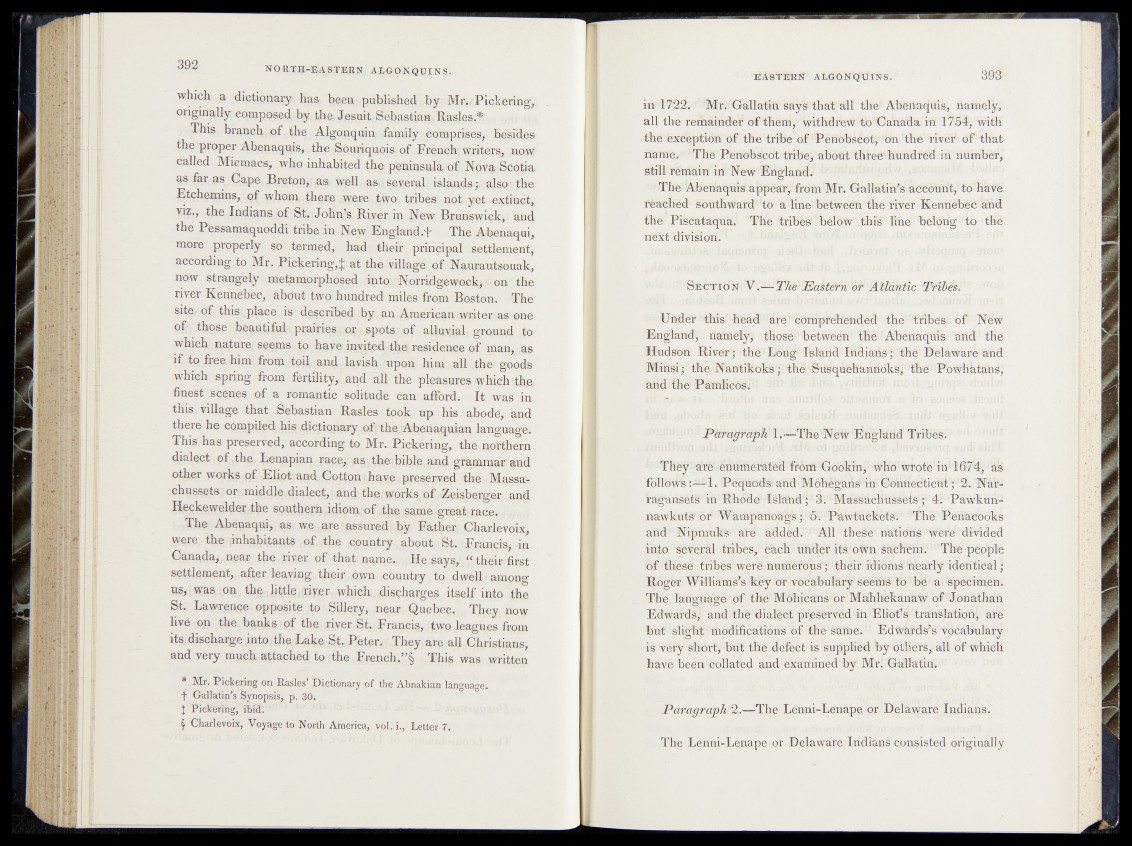
whiql|; a dictionary hpa ^B R .^ i^ iQ d y h jr, MiyPipketfog*
ongi^a|l)yr'eci^pj?ifb«^^cjtJb^ Rasjes^
> vRhn branch of the ?Algonquin family comprises, beside»
thp,proper Ahenaquis, .the j^opyiqu,©!» ofFrench writers, now
called Micmacs, who inhabited the peni^siAavpfE|^0Ye»fS€0|taa
& W :C§pe, 3xeh)ni! .as i4aada ;c also; the
Etcheflftins, of whom there. ,.wm?e two? tribe» mpf* yet extinct,
yiz., the Indians of St.;John’s Rivpr in New Brunswick,! and
the Pessamaquoddi tribe in New England.f The .Abenaqui,
more jjroperly- so termed, had their principal settlement,
according to Mr. Pickering,% at the village .of Naurautsouak,
now strangely metamorphosed mto\q^ojridgewoekj4o'h the
river Kennebec, about two hundred miles from Boston. The
»ite? ofVjhis .place fis described, by, an, American >writeEfa» one
Qfl' beautiful pmiriege.of ^^potSoof aRuyial ground to
which nature seems to have invited ithe/rqgidenoeof man, as
if-to free hjm from to il, and .-Jarish.,upon him ail the good®
which spring from fertility, and all the pleasures ^hieh?th#
finest scenes of a romantic solitude can afford. It was i®
this village that Sebastian Rasies took up his abode, and
there he compiled his dictionary ofrthe lAhenaquian language,-
This has preserved, according to Mr. Pickering, the.northern,
dialect * of the Lenapian race, as the . bib,le. and, grammar and
other works pf,JEliot and. Qotton f hay© jpreserved the Maapa«-
chusspts; or- middle dialect,j and the jaiorks, ofiZeisberger, and
Ileckewelder.tbe ^utbem idiom, of th.e ,samp>g^catrace,.
The Abepaqui, as w.e are assured by ^atheJjQharievoix,
were the inhabitant» of the qountry.j^bout St. ;P;rancis# dn
Canada, , near the river pf th a t name*? He sayg^^them fimt
settlement, after leaving their own country .to. dwell? among
US,i was, .on , tbcuhttlCiiriFer; which discharges, itself intp the
St. Lawrence opposite ,to Sillery, near Quebec, They now
live on tbe.banks pf the .river St. Francis, two leagues from
its, discharge into the Late $t, Peter. They are all, Christians,
and very much attached to the French.Ӥ This was written
* Mr. Pickering on Basies' Dictionary of the Abnakian language,
t Gallatin’s Synopsis, p. 30.
\ Pickerihg, Mwk *
f Charlevoix, Voyage to North America, vol. i., Letter 7.
iiSPPWP ^Mfl^Cilla^-fey^’thaft'Ä tHe* Abenaquis, hatnely/
all the rerbaind#ö i P f l r d m , in 1764;-with
- o f: the fnbe *b#l®>-©fiÖlliebtf4fa hhe1 rivdr of! that
liäräe^ ’ The?'PfeÄ%»ßdt'#ibfepü¥@®t dhle^hundreid in^htitriber,
still t^ 'ä in in lN fe# '® ^ ah ^ b
The'Atbehaqhfe* apfi§äf,8frÖm'Mi. ^ fe llä ti^ hcdäiMt/to -ha^?
reached Shuth#ard ' t$ Kentidb^^' ahd
the Pisdata^iiW ’THe %i1^§^b§lö^'-fb^: foe^elong^to ?tb&
next diVisidhi *
hnSEdf i ÖN- V s. '*^Th& EasternnWAtlantic Ti
-this* head-f!dfe’%(^pi^hehfffed fh # ri^ ih ^ * ‘offf-‘N^#
Snglahd1, nÄMelyy tfio^^ti^e^ttei'TAbÄHäilbife afrd* tH8
fludSbn RiVerT*Jthe'J &Mtid^Ifrdiafrs^lthe' Bhla*#'ai4' WM
Minsi;^fSe.iNantikoks j fhei^^u4hahh6k§vC!me0Pn#hatähl,!
add the' PatnMcoÄiC
' ’''ThS^?a¥e! -entithetatted‘frbm5CddRiniilWlfd1%foth4nA,l6'74, äh
fSBövmr-öhl. PdipödS äüff
iä^ari^etl^dh' Rhäde^AälMidp 31flMas#i.iäftü^efe^d:l<iPawküh^
nawkntä^^f Wämpähoä^^eKlluPa%füefibf^i3 riThe Pehiedöks
and Nipmuks are aadethu Ail ;ltbeS§r rfätiddÄ'riere* divided
intor 'seve'rM tribes/-eäch ühddr fiftFowh Sfe(eh4ih:4ifiThei:pebpl?e
öf fh^sd tribess wefe numeföhä; Riedl idioms nearly ddeiitiöÄl*
Roger Williamses key W vöfeäbuläty1 siSeffiä'tb^M^ad^ieeimen.
The lärigtiäge of fhM^Möhihäösör'Mähhekänäw ofr Jonathan
Edwards/ and the diaMWpreiei^wddh ElfMli%änMMddn] ale
büt slight ÜiodificÄtibbs ©f d h i^ in ö i“ Edvtäitlds s9rocafenlaiy
is Very shörf,' bfrt the defeht is supplied: hy iötfi&lfe/ ali^df which
have beeil “Collated Änd examined by Mr. Ga-Banti.’1'
Paragraph 2.—The Lenni-Lenape or ’Delaware Indians.
The Lenni-Lenape or Delaware Indians consisted originally